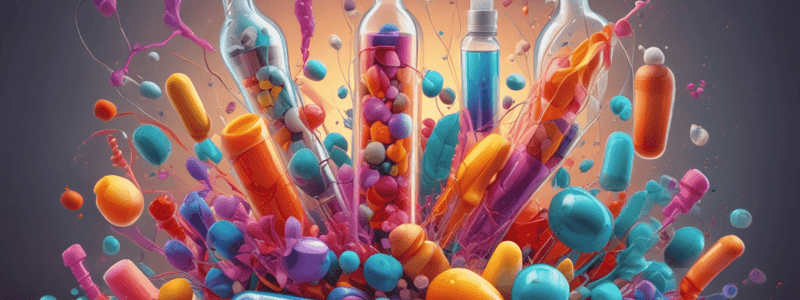Podcast
Questions and Answers
Pharmacokinetics focuses on the body's effect on drugs.
Pharmacokinetics focuses on the body's effect on drugs.
True (A)
Metabolism is the process where a drug is sent to different parts of the body.
Metabolism is the process where a drug is sent to different parts of the body.
False (B)
Routes of drug administration can include intrathecal and subcutaneous methods.
Routes of drug administration can include intrathecal and subcutaneous methods.
True (A)
Absorption involves breaking down the drug.
Absorption involves breaking down the drug.
Pharmacodynamics is the study of drugs and their interactions with living systems.
Pharmacodynamics is the study of drugs and their interactions with living systems.
Oral administration offers effective absorption due to the small surface area of the gastrointestinal tract.
Oral administration offers effective absorption due to the small surface area of the gastrointestinal tract.
Topical administration bypasses first pass metabolism.
Topical administration bypasses first pass metabolism.
Transdermal absorption is facilitated by carrier mediated transport only.
Transdermal absorption is facilitated by carrier mediated transport only.
Drug bioavailability is always 100% for drugs administered orally.
Drug bioavailability is always 100% for drugs administered orally.
Enterohepatic circulation involves substances moving from the liver to the kidneys.
Enterohepatic circulation involves substances moving from the liver to the kidneys.
Increasing the dose of a drug can compensate for first pass metabolism in all cases.
Increasing the dose of a drug can compensate for first pass metabolism in all cases.
Distribution of drugs refers to the movement of drugs from the site of action to the systemic circulation.
Distribution of drugs refers to the movement of drugs from the site of action to the systemic circulation.
Acidic drugs primarily bind to alpha-acid glycoprotein.
Acidic drugs primarily bind to alpha-acid glycoprotein.
Protein binding decreases the duration of action of a drug.
Protein binding decreases the duration of action of a drug.
The blood-brain barrier is permeable to all types of drugs.
The blood-brain barrier is permeable to all types of drugs.
During inflammation of the meninges, the blood-brain barrier becomes impermeable to drugs.
During inflammation of the meninges, the blood-brain barrier becomes impermeable to drugs.
Lipid-soluble unionized drugs cross the placental barrier more readily than lipid-insoluble drugs.
Lipid-soluble unionized drugs cross the placental barrier more readily than lipid-insoluble drugs.
The volume of distribution describes how extensively a drug is distributed compared to urine.
The volume of distribution describes how extensively a drug is distributed compared to urine.
Flashcards are hidden until you start studying




